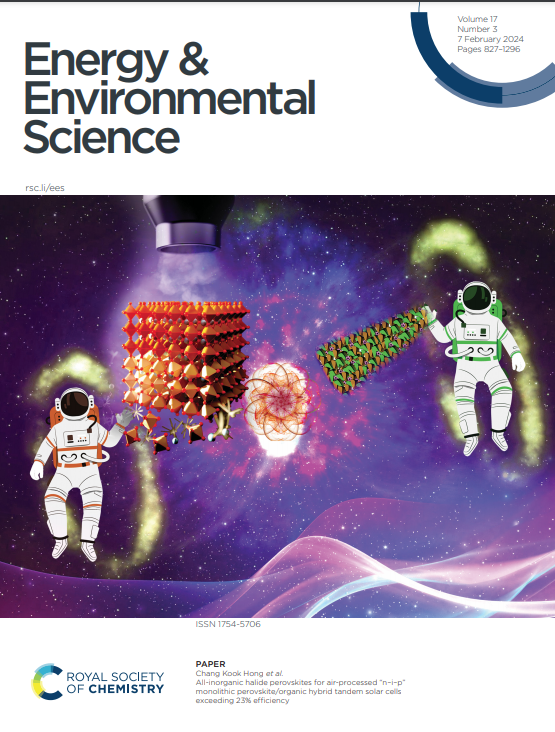ZnO电子传输层的诱导取向附着使溶液处理的传统有机太阳能电池的效率超过20%
IF 30.8
1区 材料科学
Q1 CHEMISTRY, MULTIDISCIPLINARY
引用次数: 0
摘要
采用溶液处理氧化锌(ZnO)电子传递层(etl)的高效稳定有机太阳能电池(OSCs)的发展主要受到多长度尺度结构混乱和高密度氧空位缺陷的阻碍,特别是在传统的器件结构中。在这里,通过精心设计ZnO体系中的双功能固体添加剂来微调纳米颗粒的堆积,实现了宏观和微观结构有序和表面缺陷钝化的同时调制。系统分析表明,在薄膜形成过程中,固体添加剂(DIB)分子由于强大的分子间相互作用而强烈吸附在ZnO纳米颗粒表面,提供了抑制聚集和促进均匀薄膜覆盖的空间位阻。在随后的温和热退火后,中等挥发性的DIB逐渐升华,产生粒子间自由体积,促进ZnO纳米粒子在偶极相互作用下的定向附着,同时增强粒子间Zn-O键合,有效地钝化氧空位。这种结构调节和缺陷钝化的结合导致ZnO薄膜具有更高的电子迁移率,减少复合损失和有利的能级排列。由此产生的OSCs在使用zno基etl的器件中实现了创纪录的20.1%的功率转换效率(认证为19.8%),同时具有出色的厚度公差和操作稳定性。值得注意的是,该策略还显示出与柔性器件的卓越兼容性,提供19.1%的创纪录效率,并在一系列DIB类似物中表现出广泛的适用性。本文章由计算机程序翻译,如有差异,请以英文原文为准。
Induced Oriented Attachment of ZnO Electron Transport Layer Enables Over 20% Efficiency in Solution-Processed Conventional Organic Solar Cells
The development of efficient and stable organic solar cells (OSCs) employing solution-processed zinc oxide (ZnO) electron transport layers (ETLs) is impeded primarily by structural disorder across multiple length scales and a high density of oxygen vacancy defects, particularly in conventional device architectures. Here, simultaneous modulation of macro- and microstructural ordering and surface defect passivation is achieved by meticulously designing dual-functional solid additives within the ZnO system to fine-tune nanoparticle stacking. Systematic analysis reveals that the solid additive (DIB) molecules strongly adsorb onto the surfaces of ZnO nanoparticles during film formation due to robust intermolecular interactions, providing steric hindrance that suppresses aggregation and promotes uniform film coverage. Upon subsequent mild thermal annealing, the moderately volatile DIB gradually sublimes, generating interparticle free volume that facilitates oriented attachment of ZnO nanoparticles guided by dipolar interactions, while concurrently enhancing interparticle Zn-O bonding to effectively passivate oxygen vacancies. This combination of structural regulation and defect passivation leads to ZnO films with improved electron mobility, reduced recombination losses, and favorable energy-level alignment. The resulting OSCs achieve a record power conversion efficiency of 20.1% (certified at 19.8%) among devices using ZnO-based ETLs, along with excellent thickness tolerance and operational stability. Notably, this strategy also demonstrates exceptional compatibility with flexible devices, delivering a record efficiency of 19.1%, and exhibits broad applicability across a range of DIB analogs.
求助全文
通过发布文献求助,成功后即可免费获取论文全文。
去求助
来源期刊

Energy & Environmental Science
化学-工程:化工
CiteScore
50.50
自引率
2.20%
发文量
349
审稿时长
2.2 months
期刊介绍:
Energy & Environmental Science, a peer-reviewed scientific journal, publishes original research and review articles covering interdisciplinary topics in the (bio)chemical and (bio)physical sciences, as well as chemical engineering disciplines. Published monthly by the Royal Society of Chemistry (RSC), a not-for-profit publisher, Energy & Environmental Science is recognized as a leading journal. It boasts an impressive impact factor of 8.500 as of 2009, ranking 8th among 140 journals in the category "Chemistry, Multidisciplinary," second among 71 journals in "Energy & Fuels," second among 128 journals in "Engineering, Chemical," and first among 181 scientific journals in "Environmental Sciences."
Energy & Environmental Science publishes various types of articles, including Research Papers (original scientific work), Review Articles, Perspectives, and Minireviews (feature review-type articles of broad interest), Communications (original scientific work of an urgent nature), Opinions (personal, often speculative viewpoints or hypotheses on current topics), and Analysis Articles (in-depth examination of energy-related issues).
 求助内容:
求助内容: 应助结果提醒方式:
应助结果提醒方式:


